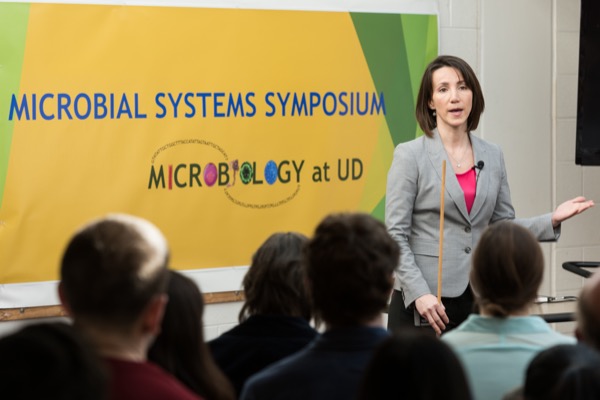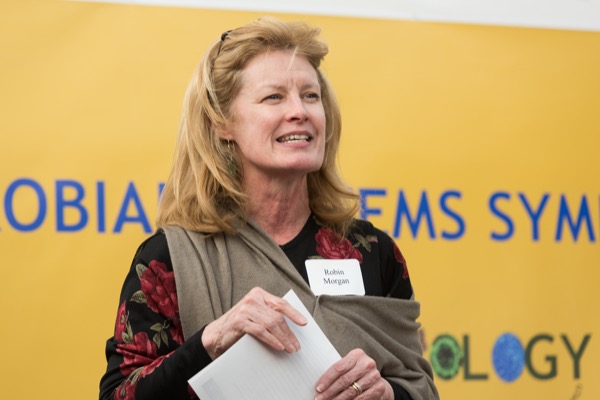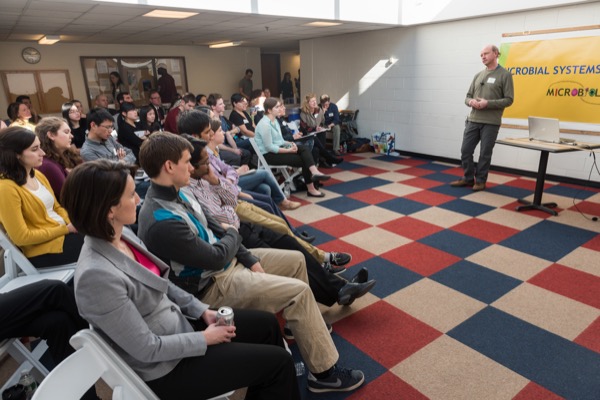


Microbial symposium
Scores gather to compare notes on microbiology research
3:59 p.m., Feb. 9, 2015--It was standing-room-only at the McKinly Laboratory atrium on Feb. 3 as researchers from across the University of Delaware gathered to talk about some of life's tiniest organisms -- microbes.
Microbes are things you can’t see with the naked eye, things that require microscopes and similar equipment -- things like bacteria, viruses, fungi, algae, protozoa. Though some might want to reach for hand sanitizer when they hear the word, not all microbes are nasty. Many are required for good health.
Research Stories
Chronic wounds
Prof. Heck's legacy
They have implications for almost every field of study, so participants in UD's second Microbial Systems Symposium came from many corners of the University.
Rosa Leon Zayas, a postdoctoral fellow in the College of Earth, Ocean, and Environment, drove up from the Hugh R. Sharp Campus in Lewes, where she works with the research group of Jennifer Biddle, assistant professor of marine science and policy, studying life at the bottom of the sea.
Doctoral student Megan Smith came from the College of Agriculture and Natural Resources, where she explores the secret life of microbes in cows' stomachs with the research group of Limin Kung Jr., S. Hallock du Pont Professor of Animal and Food Sciences.
And Eric Sakowski, a doctoral student in biological sciences, explained how merging data from two of the University's most powerful instruments -- the Illumina HiSeq 2500, which offers high-capacity DNA sequencing, and the PacBIO RS, a single-molecule sequencer -- has offered new insight into the world of viral ecology. Sakowski's work is "groundbreaking," said Thomas Hanson, professor of marine biosciences.
That sort of biodiversity, so to speak, was the whole point of the symposium. Last year, only research team leaders -- the principal investigators -- presented their work, said Fidelma Boyd, professor of biological sciences who coordinates the symposium. This year, graduate students were invited to do so, as well.
"We have more than 65 grad students from five colleges here," she said. "This is their one opportunity to see the diversity of microbiology on campus."
The potential for research and interdisciplinary work is enormous in the field of microbiology, which Robin Morgan, chair of the Department of Biological Sciences, sees as largely uncharted territory. The vast majority of microorganisms (more than 97 percent, by some estimates) have not yet been discovered, she said.
"This is a frontier like outer space," she said. "The microorganisms that have not been discovered -- I think we all know they are likely to have the answers to a lot of the world's problems."
Exposure to other research underway at the University can produce new endeavors, partnerships, discoveries and potential solutions. A chat in the hallway, an item on a poster, a different approach to a process all can shed new light on a question or a problem.
The introductions went beyond the research, of course. New hires were on hand, including Ramona Neunuebel, assistant professor of biological sciences, who explained her team's study of the survival methods used by bacterial pathogens, using the one that causes Legionnaires' disease as its model.
"What is being done is something most people overlook but something that is very important to our environment and what we do in life," said Bianca Riddick, a master's student in plant and soil sciences. "Things that are overlooked in mainstream society are here -- people looking for cures and ways to address global warming."
Riddick's work focuses on a fungus that kills enough rice to feed about 60 million people a year.
Rachel Marine, a sixth-year doctoral student in molecular biology and genetics, said the symposium demonstrated broad interest in microbiology.
She enjoyed hearing details of other research and reviewing the posters that lined the halls near the atrium.
"I think it's all interesting," she said. "I have a passion for microbiology, so I can get interested in anything."
Morgan said the University is well-positioned to lead the way as the field expands.
"Antibiotic resistance is a public health concern," she said, "and the problem of asymptomatic carriers is plaguing society. We have some really cool resources here and a lot of people across the University are microbiologists. It's a real niche for us.
"We are uniquely qualified to be a giant in microbiology."
Article by Beth Miller
Photos by Evan Krape










